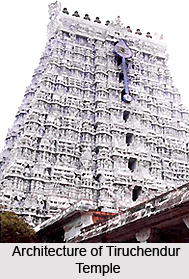 `Tiruchendur` means a sacred and prosperous town of victory. The temple was originally constructed on the sand-stone reefs of the beach, but due to corrosion by the sea, the stone began to disintegrate. Originally the temple was of a very modest construction, but during the course of about 1000 years many additions and alterations were made by different Pandya and Chera kings, their vassals, and the wealthy people of the locality, as a result of which the present gigantic structure has grown up.
`Tiruchendur` means a sacred and prosperous town of victory. The temple was originally constructed on the sand-stone reefs of the beach, but due to corrosion by the sea, the stone began to disintegrate. Originally the temple was of a very modest construction, but during the course of about 1000 years many additions and alterations were made by different Pandya and Chera kings, their vassals, and the wealthy people of the locality, as a result of which the present gigantic structure has grown up.
The Gopuram is on the west and is a gigantic structure of nine storeys with a height of 137 feet, commanding a good view of the surrounding area. History states that the Gopuram was constructed roughly 300 years ago by Desikamurtiswami, an Odukathu Tambiran of the then Head or Maha-Sannidhanam of Tiruvaduturai Mutt, Tanjore District.
Scenes depicted on the Gopuram are from the life of Saint Manikkavachakar, a chief Minister of the Pandya King, and from the interesting temple works of Avadayar Koil with-labels in Tamil.
In the ninth storey of the temple a huge bell had been hung. There is a tradition that when this bell rang for worship at mid-day, the call was relayed by a series of bells on mandapams where drummers were stationed along the route as far as the residence of Kattabomma-Nayakkan, the Poligar. At this signal, Kattabomman`s thoughts turned to God and he took his mid-day meal only after the worship at the temple was over.
About 200 ft. north of the temple there is Valli`s Cave, cut inside the natural sand-stone rock facing east towards the sea. There are two images, one dedicated to Valli and another to Dattatreya. Valli is the daughter of the king of a clan of hunters and his men followed the flight of Valli with Muruga up to this place where they met the divine couple and received their grace. Behind the frontal cave, there is a circular passage leading to another cave inside, where there is a shrine of Valli kept in a niche. The cave overlooks the sea and is an ideal spot for meditation.
There are three prakarams (circular corridors) round the temple and there are several shrines in them for other Gods. The most interesting of them is the image of Lord Vishnu installed in a hollow of rock.
Here Venkatesaperumal is seen in a standing posture and facing the east. In another cave, is the shrine of Gajalakshmi and by her side is Pallikonda Ranganatha in a recumbent posture. Sri Devi, Bhu Devi, and Nila Devi are by his side. Lord Brahma appears on a lotus from his navel. By the side of the Perumal, there are the twelve Vaishnavite Azhwars. The presence of Vishnu`s shrine with all his devotees inside a Shiva temple is a common feature in South India, demonstrating the catholicity of the Hindu religion.
The sanctum sanctorum is of Lord Subrahmanya facing east in the form of a young and beautiful ascetic, rapt in contemplative worship of Shiva, He holds in one hand a rosary of beads and in the other flowers to be offered to Lord Shiva. By His side, there is another sanctum for Arumuga or Shanmukha facing south. These are in the innermost precincts of the temple, where archana is performed to Lord Subrahmanya in conformity with strict Vedic injunctions. Male devotees are not allowed to enter the sanctum covering their chest.
About 200 yards south of this temple, at the sea-shore, there is a rare natural phenomenon inside a square. It is a well 14 sq. feet in area and with a flight of 34 steps. Inside this well, there is another small well, one square foot in extent and seven feet deep. The water in the smaller well is crystal clear and sweet to taste whereas that in the bigger well is highly sulphurous in smell and brackish. It is said that when Shanmukha`s troops returned to the shore after vanquishing Surapadman at Mahendragiri, they felt thirsty and wanted fresh water. To quench their thirst, Shanmukha planted his Ved on this spot and caused fresh water to gush out.
The principal deity of Lord Shanmukha is visible along with his consorts from the Mandapa itself. The main entrance of the temple opens towards the south into the first prakram. The artistic beauty of the temple is worth mentioning. It closely reflects the mastery of the sculptor as many lingams had been curved on a single gopuram. The Raja Gopuram is another monumental edifice of the Tiruchendur Temple.
Thus it can be concluded saying that all the features of the temple vividly reflect the architectural excellence of that era.





















